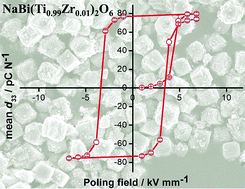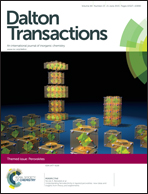An investigation of Zr doping in NaBiTi2O6 perovskite by direct hydrothermal synthesis
Abstract
The direct crystallisation of perovskites NaBi(Ti1−xZrx)2O6 with x = 0, 0.01, 0.05 and 0.1 at 240 °C is achieved from aqueous alkali (NaOH) solutions of NaBiO3, TiF3 and ZrOCl2. For each material, a single rhombohedral polymorph (R3c a ∼ 5.51 Å, c ∼ 13.50 Å) can be fitted to powder X-ray diffraction data, with Rietveld refinement showing a linear increase in lattice parameters and unit cell volume with increasing Zr content. Scanning electron microscopy shows micron-sized cube-shaped crystallites for each sample, with energy-dispersive X-ray analysis giving Bi : Ti : Zr ratios consistent with the expected substitution. Raman spectroscopy shows no perturbance of local structure upon Zr doping and the spectrum shows five broad bands, consistent with the literature on similar materials. Attempts to increase the Zr content further (x > 0.1) were unsuccessful by this hydrothermal synthesis method, leading instead to crystalline ZrO2 by-products. For NaBiTi2O6 and NaBi(Ti0.99Zr0.01)2O6 densified ceramics were prepared (∼95% density of crystallographic value) and their remnant polarisation was found to be reduced upon Zr substitution, along with a higher maximum piezoelectric coefficient, d33, measured and comparable permittivity and dielectric loss to other reported NaBiTi2O6 materials.

- This article is part of the themed collection: Perovskites

 Please wait while we load your content...
Please wait while we load your content...